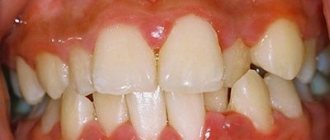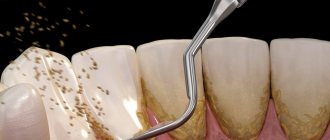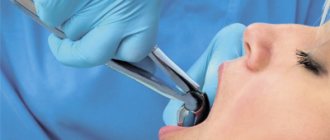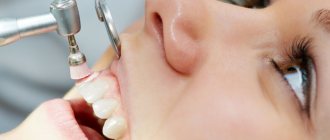Today, anesthesia in dentistry is used everywhere for a variety of procedures, from hygienic cleaning to implantation. An anesthetic injection not only provides comfort to the patient, but also significantly facilitates the doctor’s work.
Read in this article:
- How long does tooth freezing last?
- Treatment and removal - is there a difference in pain relief?
- How long does dental anesthesia last?
- What to do to make dental anesthesia go faster
- 4 tips on how to “freeze off” faster
- What to do if numbness of teeth does not go away after anesthesia
- What's the result?
The anesthetic technique is selected taking into account the type of manipulation and implies a certain exposure time. After administration of the drug, the tissues surrounding the tooth are “frozen” and stop responding to any irritants. Sometimes this lasts much longer than necessary and does not allow you to return to your usual rhythm.
Treatment and removal - is there a difference in pain relief?
There are 3 types of anesthesia most commonly used:
- application;
- infiltration;
- conductor.
Freezing during tooth extraction is mainly conductive, since it turns off large nerve trunks and lasts longer, about several hours. Teeth are treated primarily with infiltration anesthesia, the effect of which lasts from 15 minutes to 1 hour.
Applications are used to perform small procedures, often in children. Local application of Lidocaine 10% can only numb the injection site. Therefore, it can hardly be called freezing.
The type of anesthesia is determined based on which area needs to be numbed. For example, freezing when treating teeth on the upper jaw and in the area of the lower incisors is usually infiltrative: an injection is made into the transitional fold area of the diseased tooth.
Attention!
Infiltration anesthesia can also be used when removing upper or lower anterior teeth. Therefore, sensitivity in these places usually returns faster.
The transitional fold is located on the border of the lower part of the gum and the mobile mucous membrane of the cheek or lip. After administration of the medicine, an infiltrate is formed here - a kind of depot, from which the anesthetic quickly spreads to the jaw bone.
As for conduction anesthesia, it is used not only for removal, but also for treatment, especially of molars. This is due to the properties of the structure of the mandibular bone - it is more dense and voluminous. Moreover, the density and dimensions increase closer to the corners of the jaw.
Types of pain relief
There are three types of anesthesia in dental practice:
- Local – anesthesia of the oral cavity using a syringe and an anesthetic. This type of anesthesia is used most often. Local anesthesia is performed in several ways depending on the indications.
- Sedation is a superficial depression of consciousness using mild sedative intravenous drugs. Sedation puts the patient into a state of sleep, eliminates fear and anxiety, and allows treatment to be carried out in a comfortable environment for the patient and the doctor.
- General anesthesia is anesthesia that involves influencing the central nervous system. In clinical practice, anesthesia is used quite rarely. It is used in cases where treatment with other methods of pain relief is impossible.
Local anesthesia provides pain relief to the teeth, gums, jaws and soft tissues of the mouth. It comes in several types depending on the methodology:
- Conduction – anesthesia of large nerve endings at the points where the nerve exits the bone. It is used when necessary to numb the entire jaw or part of it. This type of anesthesia is used during surgical operations, implantation, and tooth extraction.
- Intraosseous – injection of an anesthetic into the bone tissue of the jaw. It is performed more often for additional pain relief at the intervention site.
- Infiltration – gradual introduction of an anesthetic solution into the soft tissues of the maxillofacial area. First, the drug is injected under the mucous membrane, then into the deeper layers of tissue. The anesthesia acts quickly, is easy to administer, and can be injected if necessary.
- Intraligamentary – injection of an anesthetic into the tooth ligament and periodontal fissure. It is used to numb one tooth using a special syringe.
- Application – superficial anesthesia of the mucous membrane using cream, gel, spray. Most often used in pediatric dentistry. It can be performed before anesthesia using a syringe to eliminate pain during injection.
How long does dental anesthesia last?
On average, the freezing effect lasts 1-2 hours. However, its duration depends on the drug used: for example, injections with Novocaine anesthetize for no more than half an hour, Bupivacaine acts for at least 2 hours. Modern clinics mainly use anesthetics containing Articaine, which freezes tissue for up to 3 hours.
The infiltration anesthesia on the upper jaw will wear off in 45 minutes at most. This is due to the structure of the maxillary bone, which is looser and better supplied with blood.
Freezing after tooth extraction will last longer if the anesthetic contains a vasoconstrictor - a substance that constricts blood vessels and prolongs pain relief.
Removal of a wisdom tooth on the lower jaw
Most people of conscious age go to the dentist because of problems with their lower wisdom teeth.
They often interfere, put pressure on neighboring molars, and cause discomfort or pain after eating. Most often, wisdom teeth in the lower jaw appear between the ages of 20 and 25, although the timing varies from person to person; for some, they may appear at the age of 16, for others closer to 40 years. In most cases, the appearance of figure eights is accompanied by various complications that require their removal. Malocclusion, difficulty in teething, tumors and trauma to the mucous membrane and much more.
What to do if numbness of teeth does not go away after anesthesia
Lack of sensitivity can last for quite a long time, especially after the removal of difficult wisdom teeth. Sometimes you have to wait 8 or even 9 hours for “defrosting”.
If all the normal deadlines have passed, and the numbness of the gums, tongue or nose does not go away, you should consult a dentist. It is possible that during the manipulations the nerve that is responsible for the innervation of the mucous membranes of the nose or tongue was damaged.
This happens when extracting figure eights with roots that come close to the mandibular nerve trunk. Fortunately, this situation is very rare, occurring in only 0.5% of patients.
But even if you fall into this half a percent, it is fixable. Over time, the nerve recovers and sensitivity returns. The bad news is that sometimes the recovery process takes several months (but no more than six months), and it is impossible to speed it up.
What to do to quickly forget about dental intervention
Very often, upon returning home, the patient continues to feel numbness in part of the jaw. This condition can cause discomfort and even mild aching pain. In order for tissue sensitivity to be restored as quickly as possible, the following rules should be followed:
- On the eve of planned dental procedures, avoid drinking alcohol , fatty and heavy foods. If a specialist recommends taking any medications, it is important to follow his prescription.
- In the case of treating caries , removing tartar, grinding down the top layer of enamel under a crown, it is permissible to massage the gums. You can also drink warm tea or heated water. These simple methods will increase local blood circulation and create conditions for the speedy release of anesthesia. But, if anesthesia was administered before tooth extraction, there should be no talk of any self-massage - touching the hole with your hands is strictly prohibited. Otherwise, you can damage the blood clot that protects the wound from the penetration of bacteria and germs. This will lead to severe inflammation and bleeding.
Don't be alarmed if the anesthetic continues to work for up to six hours. The situation will normalize on its own. If the numbness does not go away longer, this is a reason to consult a dentist again.
Other methods
Other methods of anesthesia are also used in dentistry - these are non-drug methods of pain relief.
Currently, anesthesia is performed using the following method:
- computer anesthesia - the anesthetic is administered, and the process is controlled by a computer;
- hypnosis – through hypnotic influence, superficial anesthesia occurs;
- alektroanalgesia – high-frequency electrical impulses affect specific centers of the cerebral cortex;
- Audio analgesia is a psychotropic, a kind of distracting drug.
Example of drug administration
The doctor tells the patient in advance how long tooth freezing lasts. As a rule, it all depends on what type of anesthesia was used.
Recommendations after removal
Regardless of which tooth you removed or just its root, you must follow the rules of the rehabilitation period. Then healing takes place quickly and without complications.
- Do not eat for 2-3 hours after surgery.
- Eliminate hot and solid foods from your diet for 7 days.
- Carefully walk around the socket when brushing your teeth.
- Do not pick out the blood clot and try not to disturb the hole with your tongue until it is completely healed.
- Don't rinse your mouth.
The Vimontal Clinic carries out operations of any complexity using advanced equipment. This allows you to provide assistance with maximum comfort and safety.
Features and types of anesthetics
All medications are divided according to how long they last. There are short-acting, long-acting or medium-acting remedies. In district clinics, older generation drugs are often used, for example, novocaine or lidocaine.
Novocaine is used for anesthesia
Modern drugs are used in private offices and clinics. They are produced in capsules - reservoirs into which a syringe is inserted. Such injections are painless, and all thanks to the fact that the needle is thin.
In addition, the drug does not come into contact with air, which means everything happens in complete sterility. Another plus is the exact dosage. New anesthetics used in such institutions are melivacaine and articaine.
Articaine series
Articaine is a new and frequently used remedy in private clinics. It is produced under many names and contains many substances, so you can select the right remedy for different patients.
It is customary to supplement Articaine with norepinephrine or adrenaline, after which the drug begins to have vasoconstrictor properties. Excess blood loss is eliminated, and the patient experiences minimal discomfort.
Modern medicine
Compared to lidocaine or novocaine, Articaine is several times more effective. With the correct dosage, it is possible to treat even those patients who have endocrine problems, as well as pregnant women and nursing mothers.
Mepivacaines
Drugs from this series are produced under different names, the most famous drug is Scandonest. Adrenaline is used as a supplement, which is why the effectiveness is slightly less than that of articaine.
The substance mepivacaine has a unique property - it narrows blood vessels. More often used to treat pregnant women, heart patients, and children.
Indications and advantages of local anesthesia
Since local anesthesia is used everywhere, the indications for its use are very wide. Modern drugs are of very high quality and completely safe (especially if you use them thoughtfully, having first collected a high-quality anamnesis about the patient’s health condition). The level of stress from treatment without anesthesia, and especially with acute pain, can be prohibitive - very often after this, patients refuse to visit the dentist, causing dental problems. Do not be afraid of anesthesia - you will not receive such a “dose” of the drug that will harm you, even if you have to treat your teeth for several days in a row.
Indications for local anesthesia
- removal of dental plaque,
- dental treatment of any complexity,
- performing plastic surgery on gums,
- tooth extraction,
- surgical operations in the oral cavity,
- preparation and implementation of dental implantation.
Advantages
- complete relief of any painful sensations,
- safety, no toxic effects on the body,
- rapid elimination from the body,
- minimum side effects,
- the choice of drug based on the health status and age of the patient.
What is sedation?
Sedation is a type of anesthesia that uses sedatives to put the patient into a light sleep.
Kinds:
Pharmacological – used for adult patients, through intravenous administration of the latest generation sedatives.
Oxygen – intended for children, used with a nasal mask.
Main contraindications to sedation
In adults:
- Allergy to local anesthetics
- Neuromuscular disorders
- Pregnancy;
In children:
- Under three years of age
- Cough, runny nose, rhinitis
- Epilepsy;
It is necessary to prepare for the sedation procedure. Firstly, you need to avoid eating 3-6 hours before the procedure, and secondly, avoid drinking alcohol 24 hours before.
Features of tooth extraction in pregnant women
- Pain relief methods such as sedation and general anesthesia should not be used, as this may negatively affect the general condition of the fetus.
- It is possible to use local anesthetics, since the effect on the fetus is minimal
- To obtain a dental image, it is recommended to use a radiovisiograph; X-rays are contraindicated.
- Tooth extraction can be carried out during the period from 13 to 23 weeks of pregnancy, but if there is no urgent need, then it is better to postpone the procedure;
Tooth eruption problems. Wisdom tooth removal in advance
Many patients think that if the wisdom tooth is not visible on the gum, then there is no need to worry. However, over time, this molar increases in size and begins to interfere with the others. Waiting until the wisdom molar appears can lead to the following problems:
- pain in the tooth and gum;
- caries between molars;
- curvature of the roots of a healthy chewing tooth;
- infection in the place where the molar erupts because it grows incorrectly;
- curvature of the bite.
It is easier for a doctor to pick up and remove a tooth that has not yet come out. So while there is no pain, it is better to have surgery in advance.











